Environment: Endangered Species
An endangered species is a species of animal or plant that is seriously at risk of extinction. The International Union for Conservation of Nature (IUCN), an organization funded by the European Commission, is regarded as a global authority on the world’s living species and maintains a list of the world’s endangered species. More than 8,000 scientists from 162 countries make up the IUCN’s Species Survival Commission, which designates as “threatened” any species falling within the critically endangered, endangered, and vulnerable categories. These species are assigned categories based on the level of extinction risk. Identifying a species as threatened and assigning it to one of the related categories is a complicated process, involving the analysis of multiple interconnected variables. These include population size, geographic range, and the number of breeding adults.
Risk Factors
Population Size
There are a variety of factors that put these plants and animals at risk. Most species placed on endangered lists have very small populations with a small number of breeding adults. In addition to being a problem in its own right, this can lead to a loss of genetic variation among species, since small populations of animals are forced to inbreed. The young are subsequently left vulnerable to disease and often fail to reach maturity.
Habitat
Habitat can also be a risk factor. From the clear-cutting of the Amazon rainforest for the purpose of grazing cattle to overhunting and overfishing, living species are under increasing strain in the modern world. When humans build homes, office buildings, and fun parks, preserving space for plants and animals is frequently not a priority. Loss of habitat creates a ripple effect, with animals often deprived of shelter and primary food sources that end up placing them in a vulnerable state.
Range
A plant or animal's range is a function of its habitat and is also used to assess a population's survival risks.
Environmental Factors
Finally, environmental factors such as pollution, a changing global climate, and increasingly extreme weather events are other factors placing a strain on the world’s plants and animals. Before a plant or animal is considered endangered, these factors are taken into consideration. Awareness of the problem leads to a search for solutions—and some measures are being enacted—although current trends suggest that the number of endangered species will only increase as time goes on.
Italy’s Threatened Species
Note: Numbers reflect current estimates and may vary by source.
Top Three Endangered Mammals of Italy

Marsican Brown Bear (aka Apennine Brown Bear)
This type of brown bear is only found in Italy’s Abruzzo region, a rugged, coastal area on the country’s east side that includes the Apennine Mountains, which give the bear its other common name. Loss of habitat and conflict with humans, including illegal hunting, threaten the Marsican brown bear. Another factor affecting the bears’ survival is a lack of genetic diversity, as small, isolated populations will inbreed. This can affect the health of cubs, as they may be more susceptible to disease which causes them to fail to reach maturity.
Mediterranean Monk Seal
Once an abundant species, the Mediterranean monk seal is now an endangered species primarily due to human influence. Hunting of the seals for their skin reduced the animals’ population significantly, and fisherman will kill them as the seals are seen as competition for fish. Other factors impacting their population are the seals’ entanglement in fishing nets, loss of habitat, disease, and the effects of toxic algal blooms. Though once a species that gave birth to their young on beaches, the seals now rest and birth in caves, a result attributed to persecution by humans.
Italian Wolf (aka Apennine Wolf)
This subspecies of grey wolf lives in Italy’s Apennine Mountains, a rugged area located along the country’s east coast, as well as the Western Alps in the country’s northwest. Illegal hunting greatly affected the wolves’ population, which subsequently led to their gaining protected status in Italy in the 1970s. Though Italian wolf numbers have risen after their brush with extinction, there are still factors affecting them, including loss of prey (deer and goat species, wild boar) due to human hunting, loss of habitat, and crossbreeding with domestic dogs. Additionally, small, isolated populations that are restricted to certain geographical areas often lack genetic diversity, as inbreeding can result in increased susceptibility to disease and cause the wolves to fail to reach maturity. The wolves may also be killed illegally by livestock breeders.

Other Endangered Mammals of Italy
Loss of habitat and conflict with humans, including illegal hunting, are the primary reasons resulting in Italy’s endangered species. These include the wild goat (aka common ibex) and the mouflon, a wild sheep that is the ancestor to all modern sheep species. Some animals become endangered as they need to compete for limited resources with other species, like the Corsican hare, which is in competition with the European rabbit and European hare—a species the Corsican hare is often confused with, making enforcement of its protected status difficult. The goat-antelope Apennine chamois, garden dormouse, and Eurasian otter are endangered, the latter of which has a small, isolated population in Italy and faces a loss of habitat as well as water pollution. Additionally, several bat species are endangered including the long-fingered bat, Bechstein’s bat, Mediterranean horseshoe bat, Mehely’s horseshoe bat, and Geoffroy’s bat due to disease, diminished food supply, loss or fragmentation of habitat, and the destruction of the roosts where they rest and raise their offspring. Bats are also killed out of fear and from misunderstanding, as they were long believed to host more viruses detrimental to humans than other mammal species, something that is untrue.

Endangered Mollusks of Italy
A large number of mollusks, a group which includes snails, slugs, mussels, and clams, are endangered. This is true in part due to the fact that non-marine mollusks, which live on land and in freshwater, comprise the second-most diverse group of species. Most extinct mollusks have come from the non-marine category. Factors affecting mollusks include loss of habitat due to urban and agricultural development, which can include the introduction of non-native plant and animal species. Loss of a food source and the impact of predator species—often introduced in efforts to maintain the population of another species—lead to a decline in numbers. Other adverse influences on mollusks include dam building and other construction, wetland drainage, dredging, pollution, and toxic sediment. Italy’s endangered mollusks include Cantareus mazzullii, Chondrina oligodonta, Ciliellopsis oglasae, and Cochlostoma canestrinii, all of which are species of land snail.
Endangered Plants of Italy
Loss of habitat, most often due to human activity, is the main factor affecting Italy’s endangered plants. These include Aquilegia barbaricina, a type of columbine only found in Sardinia, Anchusa crispa, and flowering plants Bupleurum elatum and Bupleurum dianthifolium. Other issues affecting the plants are pollution and a limited geographical range, a key factor to Italy’s endangered Bupleurum species, which are are native to Italy and exist among the country’s shrubby, Mediterranean vegetation.

Endangered Invertebrates of Italy
Aside from mollusks, other invertebrates—those species lacking a backbone—include sponges, jellyfish, corals, sea anemones, sea urchins, worms, leeches, insects, spiders, crabs, and many more. This expansive category explains the high number of endangered invertebrates in Italy, which include the broad sea fan and great raft spider, as well as crustaceans including Carinurella paradoxa and Metacyclops gasparoi. Endangered insects include the Apollo butterfly and Carabo beetle. A number of factors affect these species, including loss of habitat due to human activity, invasive and predator species, wetland drainage, dredging, pollution, and toxic sediment.
Article written for World Trade Press by Felicia Topp.
Copyright © 1993—2025 World Trade Press. All rights reserved.

 Italy
Italy 